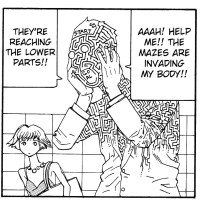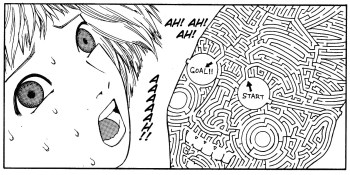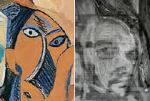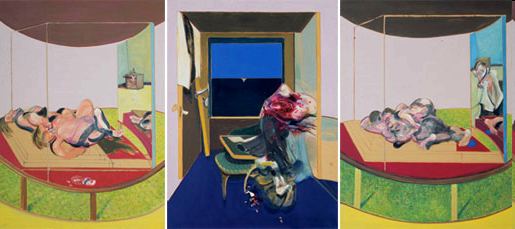A Polyptychal Discursion by Daniel Rourke
This text, designed with its own concerns in mind, diverges on many trajectories, crossing over itself, intersecting its arguments and statements with images and forms which question the traditional logic of the essay. This text will become enabled not through a writer's statements, but through a reader's response. A spiral of concepts ruptures the words, pulling you, the reader, into the written phrase. Response is required of any reading. The internet is a form capable of allowing a reader's response to influence the writer's trajectory; to send the written back into itself, melding its writer and its reader as one critical engagement. This text requires your writing.  Works of art may embody a mimesis (imitation) of reality within themselves or as an organising principle of their making/crafting, but in turn mimesis in art always speaks of the separation between subject and object.
In Plato’s dialogue, Phaedrus, Socrates elucidates an argument against writing. The fact that this dialogue still remains is due to his pupil, Plato, using the new critical form his mentor disagreed with to commit it to cultural memory. Socrates envisaged the crest of a wave which, in only two generations, would crash down over the critical tradition he represented. The oral arguments of Socrates were advanced through Plato’s written pursuit. In turn, Plato’s own pupil, Aristotle, would use writing, reading and the diagram to propound new modes of critical argument which perhaps, only two generations earlier, would not have been possible. We stand at present on the crest of our own critical wave. From orality to textuality we now move towards a hypertextual, data-driven, digital, 'New Media' revolution. The impact that this revolution will have on the acquisition and transmission of language, and the effect in turn imparted upon mind and the matter of thought and consciousness are interesting in their own right. For my purposes though, and as a distant echo to some of Socrates’ concerns, I perceive the current digital momentum behind language and textual technology as a creative force that will fundamentally alter the 'written' model. Writing did not destroy the critical mimesis propounded through Socrates’ oral tradition. Writing supplemented the oral tradition in ways Socrates, Plato and Aristotle were incapable of imagining. ‘Traditional’ forms of text are at present under similar supplementary transition/translation. The rhetoric and critique surrounding text is under duress from ‘fast encroaching’ digital and hypertextual mediums, or what Marjorie Perloff calls “the reading-writing mechanism[s] of the new electronic page”. |
The objects of the written sentence, of the parchment, the book or the footnote, work to imitate the notions of the writer, and, as Roland Barthes suggested, the reader. Because the book exists as a spatial artefact read over time its mimetic success or failure (and thus the distance between subject and object) must also be considered in spatial and temporal terms. In short, the mode in which a notion, a narrative or a critical position is crafted has a bearing on the kind of work that it can do. An oral argument is ontologically different to one written in the footnote of a book, which in turn is ontologically different to one stored in an internet archive and retrieved onto a computer screen.  Hinged along its conjunctions, a concertinaed polyptych may stand unaided, like a screen or divide. An art-form composed of three or more panels that can be folded and considered from a variety of perspectives.  Autographic artefacts manifest their mimesis directly (i.e. in a single painting, sculpture or performance). In contrast, allographic artefacts are ideal and can exist across several non-identical objects. Allographic works can come in multiple versions (a revised edition of a book) or can be incomplete (fragmented and/or discursive) or indirect (through reproductions, descriptions and copies/simulations). The mimesis of an allographic work, therefore, is carried out by the workings of art. Put simply: the work allographic art does, is the work of art. In his 2009 essay Maybe it would be better if we worked in groups of three?, Liam Gillick enables ‘The Discursive’ model of contemporary art and curatorial practice. The discursive “is the offspring of critical theory and improvised, self-organized structures. It is the basis of art that involves the dissemination of information”. For 'a text’ the discursive can be understood as a decentralised mimesis. The artefact's embodiment is dispersed, as in the hyperlinked texts of the webpage or the digital archive. Seth Price, in his 2008 work Dispersion reminds us of the notion of the palimpsest, describing the layers of potential in Duchamp’s, Fountain. The traditional palimpsest embodies a mimetic potential in its hidden layers, requiring a peeling away from the outside. In contrast, the discursive palimpsest is constantly engaged in its own peeling; in its own revealing. Digital texts are inherently discursive. Because digital texts are fragmented and dispersed over time and space their outputs can more readily become their inputs; their readers can more readily become their writers:
What interests me in particular about the digital shift becomes evident once text attempts to reflect back upon its own workings. When we critically assess what causes text to function; when we ask questions of the ontology of text, of its mimetic abilities to impart information and transpose thought onto the page, we use text itself as the medium of our expression. The invention of the alphabet and the punctuated sentence, of the page and the book, of the paragraph and the footnote have all had major impacts on the kind of work that text (and thus thought) can do. So too has the digital screen and the browser, the internet and the searchable archive, email and hypertext impacted on the mimetic exchange between thought, language, text, writer/artist and reader/viewer. Any practical examination that occurs within and in response to new mediums of text will have to itself be of an evolving capacity. Many works about the technology of writing have become obsolete even as they were being drafted, printed or thrown onto a HTML web page. The book artefact is obsolete when it comes to addressing these concerns, not because the book is not multiplicitous in its abilities to express and influence a dialogue, but because the book artefact is (in many respects) static and changes only from draft to re-print, press to re-draft, paperback to hardback. A book about the impact/possibilities of hypertext is out of date almost as soon as it goes to press: text changes faster than the book-form is capable of examining. A new writing practice is therefore needed, one that evolves as it catalyses its own arguments; as it sustains its own textual processes. A new writing method which changes as it expresses. In 2004 Caroline Bergvall presented a new form of her poetic work, Éclat. Its translation from a ‘traditionally’ bound book format to an internet-based, screen format was itself a creative act. Bergvall and designer Marit Münzberg worked to re-perform the poetics of Éclat in a new mode of textual presentation. The web-based Éclatcalls into question the bounded limits of the book and page. Language leaks from within a frame, permeating the negative space beyond; effecting a disruption of the traditional relationship between written language and the artefacts which carry and/or restrict it. Caroline Bergvall’s work takes web-based poetics to places that, arguably, print-based poetics is incapable of going. Discursive practice occurs across disciplines in what Nicolas Bourriaud calls an 'Altermodern' manner. This approach enables a dialogue between ‘traditional’ and ‘emerging’ artistic forms and helps develop a discursive dialogue between the written word and formats, such as the internet, which enable it. In the last few months I have been confronted by a series of striking images. In isolation they speak of ideals transcended and of instants stretching out across epochs. But brought into conjunction, as in the kind of polyptych paid homage to in the works of Hieronymus Bosch and Francis Bacon, the borders, boundaries, folds, hinges, horizons between them cause them to mingle as a single division. Each image has its own boundary and each boundary in the polyptych beguiles a new image. In bringing them together greater significance is imparted by each individual image. It is the whole that encloses around these words now; the hinges snapping shut. Textual modes like the internet are under constant duress from within their own structures. Because they constantly evolve as forms, practical assessment of their impact on written phenomenon is difficult. It is in their very evolutionary nature, in the ongoing feedback that occurs between the user and the user experience; the technology and the interface; the writer and the reader, that make these new mediums so unique. As in the polyptych, the allographic and the discursive, text must be renewed. Text must be turned back upon itself, so that its form typifies its content, and its content exemplifies its form. Only when the writer understands the spoken and the speaker understands the thought will the writing be allowed to begin. |



